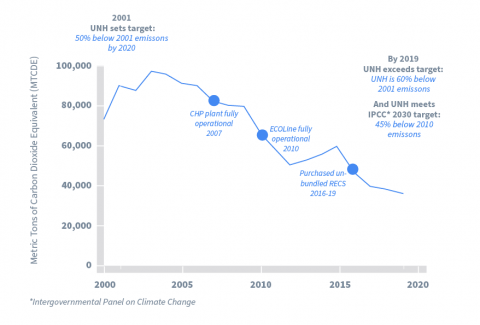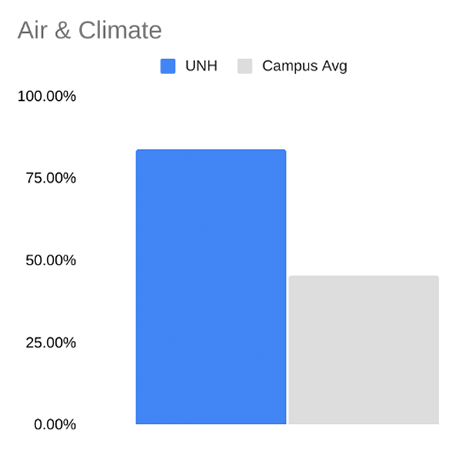>50%
More than 50% greenhouse gas reductions from baseline
2/3
Emitting 2/3 less carbon pollution than the average campus
C & N
One of the first campuses to track carbon & nitrogen footprints
Climate & Emissions
UNH has long been a leader in climate and emissions scholarship and operational best practices. UNH was one of the Charter Signatories to the Climate Commitment in 2006. This commitment, in which we are joined by hundreds of other U.S. campuses, commits UNH to a goal of carbon neutrality and requires the university to track and publicly report its carbon footprint and maintain an up-to-date Climate Action Plan (WildCAP). UNH set an ambitious goal of halving our emissions between 2001 and 2020 and achieved those reductions before our target date.
Our Progress: 2001-2019 UNH Total Greenhouse Gas Emissions in Comparison to Target Commitments

With the adoption of WildCAP 2021, UNH has set a new goal of reducing its primary emissions (Scope 1 and Scope 2) 75% below its 2010 emissions levels by 2030. This is in line with what scientists say is the level of reduction needed globally.
In addition, UNH also reports air emissions from its cogeneration plant and was one of the first campuses to begin tracking our nitrogen footprint. It has reduced its nitrogen footprint 26% since 2014.

STARS EVALUATION

UNH earned 84% of total points (9.24/11) compared to an AASHE member average of 45.54%.
STARS "seeks to recognize institutions that are measuring and reducing their greenhouse gas and air pollutant emissions. In addition, institutions that inventory and take steps to reduce their air pollutant emissions can positively impact the health of the campus community, as well as the health of their local communities and regions."
Learn more about our efforts:
The UNH Durham campus's climate action plan –called “WildCAP” after the university’s wildcat mascot—consolidates the energy and climate mitigation and adaptation planning and work being done across campus into a coherent framework that guides UNH Durham.
WildCAP is written and implemented by the UNH Energy Task Force (ETF) with input from the campus community. The first version of WildCAP was published in 2009, the next update was issued in 2014, and the newest update in 2021.
WildCAP 2021 Update
WildCAP 2014 Update
The Energy Task Force updated WildCAP throughout 2013-2014 to take UNH through its first target deadline of 2020.
WildCAP 2009
UNH was one of the first campuses in the world to estimate its contribution to global climate change. The Sustainability Institute manages the process of updating UNH’s carbon footprint regularly and reports it to Second Nature.
- FY22 GHG update
- Figure: Emissions through FY19
- Presentation of UNH’s FY18 overall carbon footprint
- Presentation of UNH’s Food footprint
- ETF Annual Report 2018 (FY17 emissions)
- FY14 Update Public Report and FY14 Technical Report
- FY11 Update Public Report and FY11 Update Technical Report
- FY09 Update Report
- FY07 Update Report
- FY05 Update Report
- 1990-2003 Executive Summary and Full Report
- 1990-2000 Executive Summaryand Full Report
Nitrogen is a significant (and too often overlooked) global pollutant that contributes not only to climate change but also to water quality and air quality degradation. A nitrogen footprint connects campus activities with the resulting nitrogen pollution released to the environment. The largest contributors to a campus' nitrogen include food purchases, utilities, and transportation.
Beginning in 2015, UNH was one of a handful of campuses that began tracking its own nitrogen footprint, measuring baseline FY 2014 nitrogen pollution at 186 metric tons of nitrogen. The largest contributors were food purchases (72%), transportation (13%), and utilities (8%).
This work to track and manage our own nitrogen footprint at UNH is important locally because it allows for a more comprehensive understanding of our environmental impact, including the ways in which we contribute to the urgent nitrogen pollution problem in the Great Bay watershed. It is allowing us to develop, and further make the case for, setting targets and implementing management strategies for reducing this impact.
- Nitrogen Footprint introduction (pdf slides)
- UNH's food nitrogen footprint [5-minute video, prepared July 2020]
- The local nitrogen footprint [5-minute video, prepared July 2020]
- UNH Nitrogen Footprint 2014-2022 (slide)
Tracking and managing the environmental “footprint” of a campus, community, or business is a skill that is increasingly in demand. UNH researchers have been working on developing tools, standards, and methods for understanding carbon and nitrogen footprints for two decades.
The Sustainability Indicator Management and Analysis Platform (SIMAP) was developed to help organizations undertake this task, and hundreds of organizations across the globe, including UNH, use it to support their carbon and nitrogen management efforts. UNH now offers a Certificate Program in Carbon Footprinting to help community members at and beyond UNH learn this marketable and valuable skill.
